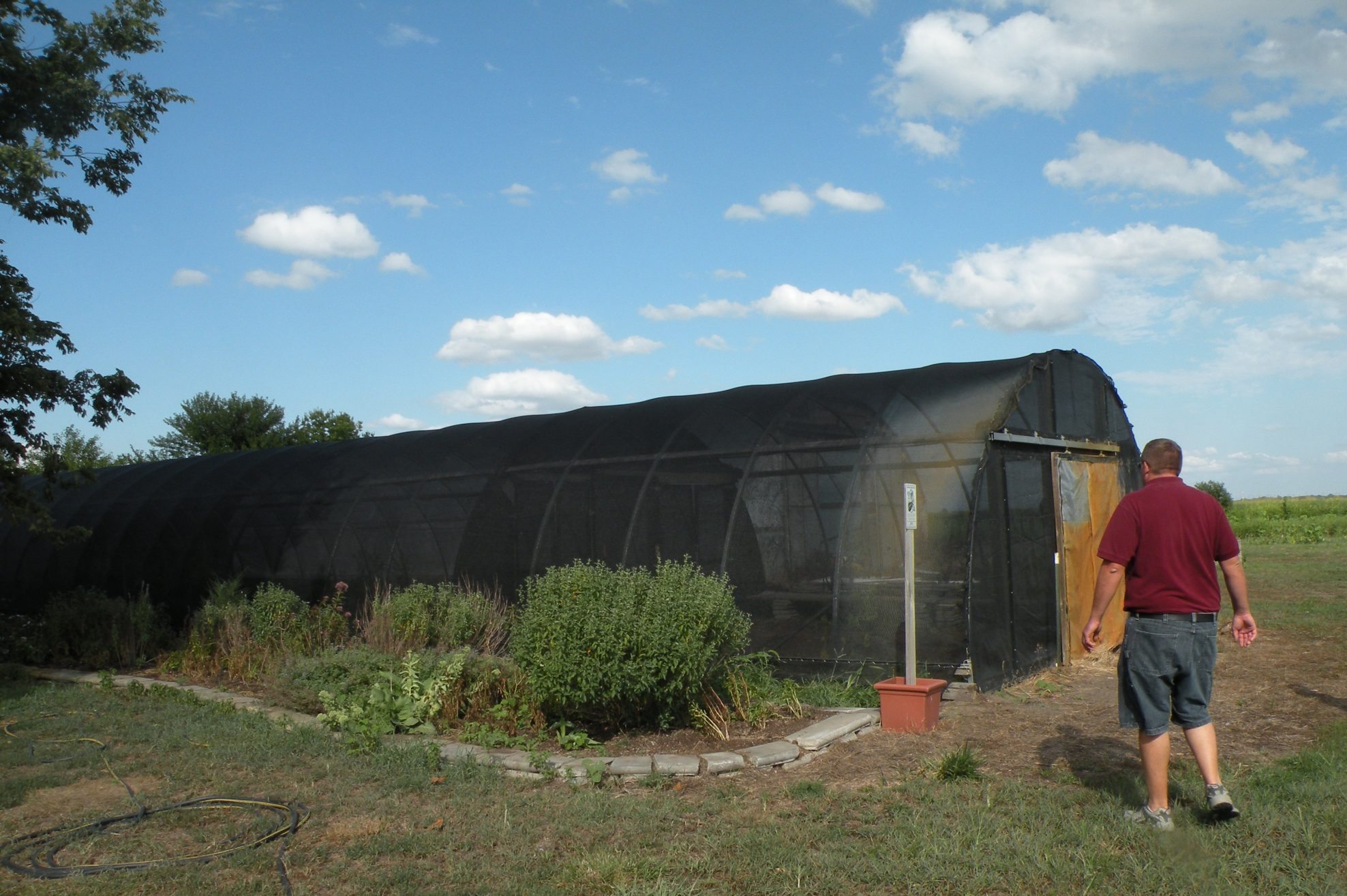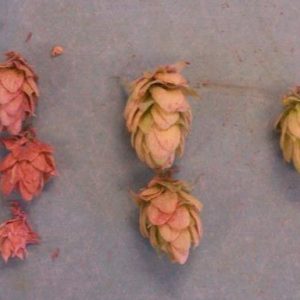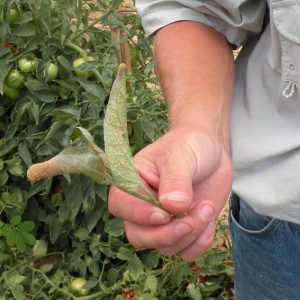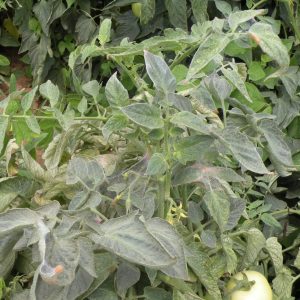Farming

Integrated pest management (IPM) is an economically feasible, environmentally friendly, and socially responsible way of farming. Learn about its application in high tunnel crop production.
Scope of Integrated Pest Management in High Tunnels
IPM is based on the principle of economic thresholds. For example, pests are managed only when populations exceed certain levels as determined by the type of crop, growth stage, insect pest species, and the ability of plants to tolerate pest damage. High tunnel crops tend to be grown for an extended season, which makes them attractive to many pests. Because of their open sides, high tunnels are considered semi-open structures with insect control benefits accruing from early crop production before the insect pest population becomes too high.
How Does a High Tunnel Microenvironment Moderate Pest Populations?
Before describing various pest species that may occur in a high tunnel crop, it is important to examine some key features of the microenvironment that can moderate pest populations. Some key microenvironment issues in the high tunnel are as follows:
- Passive ventilation. Because ventilation inside high tunnels is achieved by natural air movement aided by the rolling sides, air movement could become restricted as the plant canopy inside thickens. This results in pockets of high temperature and humidity inside the crop canopy. Many insects, such as aphids and whiteflies, prefer high-moisture conditions. Initial infestation of those insects may rapidly increase from favorable hot spots.
- Exclusion of rainfall. The plastic used in high tunnels forms a barrier to rainfall, thereby, necessitating the use of irrigation. Rainfall is unfavorable to many insect pests not only because of the direct force of falling droplets but also because the moisture promotes the development of diseases that cause natural epidemics in insect populations. However, the lack of rainfall under a high tunnel reduces the effectiveness of insect pathogens.
- Planting density and diversity. High tunnels are limited by size and design; therefore, producers tend to plant crops in high density and mixes. Thus, many plant species may be grown by farmers under a single structure—or monocropping may be favored. Polyphagous insects, which feed on plants belonging to different families, are serious pests of fruits and vegetables. Corn earworm (tomato fruitworm), tobacco budworm, thrips, stink bugs, and leaffooted bugs are a few examples of polyphagous insects that readily migrate between host crops. With a diverse array of crops under one high tunnel (figure 2), pest management could be difficult due to insect migration between crops. Multiple cropping may also limit the effectiveness of synthetic insecticides due to thick planting.
Insect Monitoring Inside and Around a High Tunnel
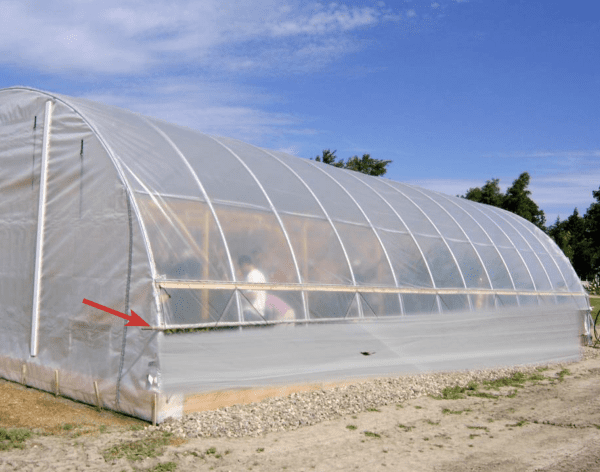
Figure 1. High tunnel with insect screen on rolling sides (arrow) may exclude pests. (Conceptual photo: A. Majumdar)
The first steps to the correct practice of integrated pest management are early pest detection, monitoring, and scouting, with emphasis on the correct identification of pests. Many nocturnal moths and beetles can be monitored continuously using commercial pheromone traps, which indicate insect density and activity throughout the season. Pheromone traps are a scouting tool that may be ineffective in trapping out all insects that get under a high tunnel. Purchase pheromone traps and lures from reliable sources to avoid disappointing results. Consult regional Extension agents for sources and deployment of traps.
Insect Pest Exclusion Inside a High Tunnel
An important aspect of IPM is the prevention of pests. Reports are mixed regarding the direct benefit of high tunnels for crop protection by insect exclusion. High tunnels may contribute to a slight reduction of pest pressure by acting as physical barriers to migratory insects. Insect netting may be integrated with high tunnels for taking advantage of multiple insect exclusion (figure 1). Insect screens with a low mesh size (large openings) can be installed, along with screen doors at the entrances to prevent medium- and large-sized insects from entering the structure while the side walls are open during the day, without reducing air movement inside the crop canopy. High tunnel structures can also be made into a net house (figure 2) using low-cost insect netting or shade cloth.
Insecticides for High Tunnel Vegetable Production
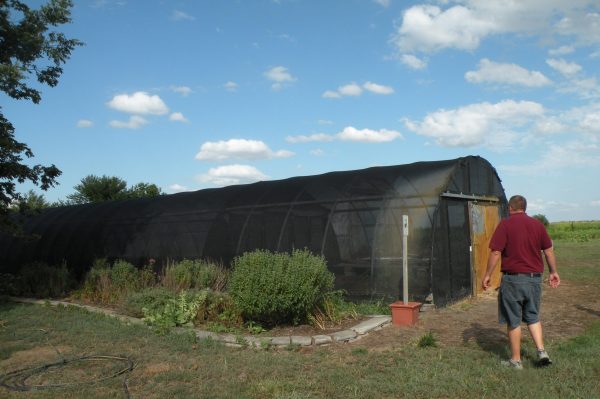
Figure 2. Low-cost insect netting or shade cloth can be used for high tunnel structures
Pesticide labels do not have separate restrictions for high tunnel crop production, so growers may use registered insecticides for rescue treatments. However, growers should be aware of the following approaches to insecticide usage inside high tunnels:
Use of systemic insecticides
Conventional producers can apply many new insecticides via the drip irrigation system that eliminates the use of overhead insecticide spray. The systemic insecticides are absorbed by the plant’s root system and remain effective for several weeks. The application of systemic insecticides has many restrictions (see product label) to reduce or minimize nontarget effects. Consult the Southeastern U.S. Crop Production Handbook for more insecticide information.
Spot treatment adequate for treating hot spots
Spot treatments inside the high tunnel will minimize the cost of insecticides as well as conserve natural enemies.
High temperature inside tunnels
Pesticides should not be applied if their use violates temperature recommendations mentioned on the product label.
Structural damage due to drift
Although wind velocity inside a high tunnel is expected to be low, casual application of synthetic chemicals may damage the plastic and metal parts or leave undesirable residues that may not break down for extended time periods. Refer to the pesticide label for specific restrictions.
Alternative pest management strategies
Alternative pest management tactics can be used effectively. Use of cultural control methods (early planting and harvest, sanitation, vigorous crop varieties, trap cropping, etc.), natural enemy conservation, and biological control (table 1) are some environmentally friendly IPM tactics. Growers are encouraged to adopt alternative tactics before resorting to the use of synthetic insecticides inside a high tunnel.
Examples of Insect Pests Inside High Tunnels
It is common to find small sucking insect pests on high tunnel crops. Because these small sucking insects are difficult to control, this publication focuses on aphids, whiteflies, and thrips management. Due to the dry environment, spider mites may be common and will need to be managed. Table 1 provides a list of natural enemies that can be released inside a high tunnel for pest management. Do not use synthetic insecticide before the release of biological control agents.
Aphids
Identification
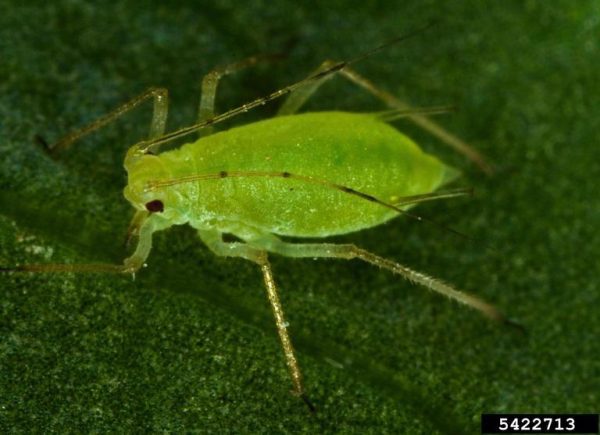
Figure 3. Green peach aphid. (Photo credit: David Cappaert, Michigan State University. bugwood.org)
Several species of aphids are known to occur in both greenhouse and field crops and can be the first invaders of crops in a high tunnel. Green peach aphid (figure 3), potato aphid, and melon aphid are common species. Aphids can be distinguished by locating a pair of tail pipes or cornicles at the end of the abdomen. Aphid populations may increase rapidly in densely packed high tunnels, if undetected or left unmanaged.
Monitoring techniques
It is important to monitor aphids using yellow sticky cards to detect migrating populations (alate aphids). Yellow sticky traps should be placed close to the plants, about 3 to 4 per tunnel, to increase the accuracy of observation. Sticky cards should be checked daily (early season) or weekly (late season). While scouting crops, check the underside of leaves and examine the growing points for live aphids.
Organic management
Aphids can also be managed by weekly (or more frequent) applications of insecticidal soap and horticultural and paraffinic oils. Growers can treat aphid hot spots and save on the cost of insecticide applications. Naturalis O (BioWorks, Inc., VA) is a broad- spectrum organic formulation containing the fungus Beauveria bassiana with activity against aphids, thrips, and whiteflies (most effective against immature stages). These alternative insecticides may persist longer under the shaded condition of a high tunnel compared to the open field. Biological control agents like lacewings and lady beetles provide good suppression of aphids and other pests when pest pressures are low. Periodic release of these natural enemies is needed along with reduction in the use of pesticides.
Whiteflies
Identification
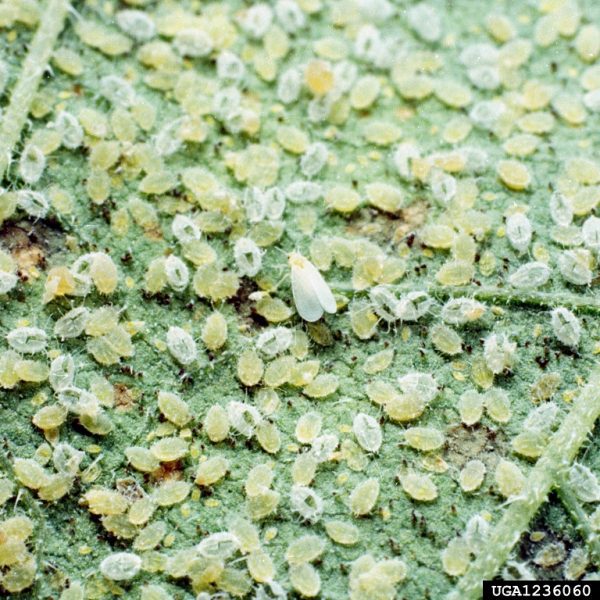
Figure 4. Whiteflies. (Photo credit: Clemson University, USDA Cooperative Extension Slide Series, bugwood.org)
Common whitefly species found in field and greenhouse conditions can also infest crops inside high tunnels. Examples are greenhouse and silverleaf whiteflies. Proper identification of whiteflies may require a strong magnifier for viewing after sampling (figure 4). Under magnification, the greenhouse whitefly appears to have flattened wings, whereas the silverleaf whitefly holds its wings in a tentlike position. Citrus whiteflies are also prevalent in Alabama and can be found on many host plants, not just fruits. Whiteflies are small, white-winged insects that pass through egg, four larval stages, and a pupal stage before becoming winged adults. Whitefly feeding can cause direct leaf damage by their piercing/ sucking mouthparts or indirect damage by excretion of honeydew, giving rise to sooty mold on leaves. Secondary insect pests can also be attracted to the honeydew.
Monitoring techniques
A simple way of collecting whiteflies, aphids, and thrips is by closing a resealable plastic bag over leaves or flowers and vigorously shaking the plant part. Flatten the bag by excluding air and holding it over a sheet of colored paper. Start scouting soon after crop establishment and look for whiteflies on the underside of leaves. Yellow sticky cards placed close to the plant canopy could be effective in detecting these insects. Storms and high winds may move whiteflies to a new location, so scouting should be repeated after such weather events.
Organic management
Periodic applications of insecticidal soap, pyrethrin, neem, or insecticidal oil can suppress populations. Check insecticide label before application to avoid phytotoxicity.
Thrips
Identification
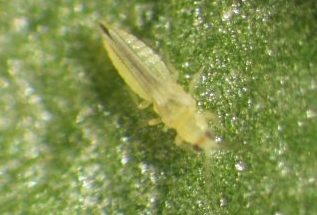
Figure 5. Thrips. (Photo credit: Andrew Derksen, FDACS/DPI, bugwood.org)
Thrips are elongated and slender insects ranging in size from 0.02 inch to 0.55 inch. Adults have two pairs of narrow wings that are held over the body at rest. The edges of both the forewings and hindwings are fringed with setae (hair). Thrips cause damage by transmitting plant diseases as they feed. More than 20 plant viruses, including spotted wilt, are known to be transmitted by thrips.
Monitoring techniques
Scouting should start soon after plant establishment. Look for thrips on the underside of leaves or inside flowers. Thrips generally migrate from surrounding weeds as they dry up. The use of blue or yellow sticky cards is effective in monitoring thrips.
Organic management
The use of sulfur, insecticidal soap, and diatomaceous earth has been shown effective in suppressing thrips and other pests on several crops. Spray formulations of Beauveria bassiana (Mycotrol-O) and spinosyn (Entrust) are also effective against thrips for organic crop production.
Spider mites
Identification
Several mite species (figure 7) are important fruit and vegetable crop pests. Mites are not insects, but are more closely related to spiders. They have four pairs of legs, no antennae, and an oval body. Most spider mites have the ability to produce fine silk webbing (figure 8). Magnification is required to see spider mites, because they are usually tiny, less than 1/50 inch in adult stage. Spider mites damage plant cells using their piercing mouthparts, and extensive feeding causes yellow or white speckles. When the feeding spots grow together, the foliage takes on a yellow or bronzed coloration.
Monitoring techniques
No traps or lures are available for monitoring mites. Shake leaves over a white sheet of paper and watch for tiny moving specks. Species identification may require sending samples to experts. Otherwise, watch for damage symptoms, such as bronzing in mite hot spots. Treat locally inside the high tunnel.
Organic management
Spider mites can be controlled with insecticidal oils and soaps. Thorough plant coverage with soaps and oils is important for good mite control. Treatments should begin when mite populations are low. Predatory mites can also be used in the early season along with reduced or no use of miticide.
- Figure 6. Spider mites. (Photo credit: David Gent, USDA Agricultural Research Service, bugwood.org)
- Figure 7. Two spotted spider mites in a mass on the left tip.
- Figure 8. Extensive webbing from spider mites is visible in advanced stages of infestation.
Consult the regional Extension agent in your area for updates or thorough consultation before and as you start high tunnel crop production. Extension also offers regional fruit and vegetable production meetings and training field days to help growers stay updated on new crop production technologies. The organic initiative in commercial horticulture provides support to small and low-resource farmers. Producers can apply for grants through the Alabama SARE program at www. southernsare.org/SARE-in-Your-State/Alabama.
Table 1. Predators and Parasitic Wasps Commercially Available for Insect Pest Management in Fruits and Vegetables
Disclaimer: Product availability may change from time to time. Other products or suppliers can be recommended by regional Extension agents. Call the toll-free numbers provided for each manufacturer to find current lists of products or visit company websites. Mention of names does not mean endorsement of products by Alabama Cooperative Extension System.
| Target Insect | Biological Control Agent | Common Name | Mode of Action | Examples of Suppliers & Products – Koppert Biological Systems | Examples of Suppliers & Products – Syngenta-Bioline |
|---|---|---|---|---|---|
| Aphid | Adalia bipunctata | Lady beetle | Predator | Aphidalia | Adalline b |
| Aphidoletes aphidimyza | Gall midge | Predator | Aphidend | Aphidoline | |
| Chrysoperla carnea | Lacewing | Predator | Chrysopa | Chrysoline c | |
| Episyrphus balteatus | Syrphid fly | Predator | Syrphidend | - | |
| Aphelinus abdominalis | Parasitic wasp | Internal parasite | Aphlin | Apheline | |
Aphidius colemani | Parasitic wasp | Internal parasite | Aphipar | Aphiline c | |
| Leafminer | Dacnusa sibrica | Parasitic wasp | Internal parasite | Diminex | Dacdigline |
Diglyphus isaea | Diglyphus isaea | Parasitic wasp | Internal parasite | Miglyphus | Digline i |
Mealy bug | Anagurus pseudococci | Parasitic wasp | Internal parasite | Citripar | - |
| Leptomastix dactylopii | Parasitic wasp | Internal parasite | Leptopar | - | |
| Coccidoxenoides perminutus | Parasitic wasp | Internal parasite | Planopar | - | |
| Cryptolaemus montrouzieri | Predatory beetle | Predator | Cryptobug | Cryptoline m | |
| Caterpillars | Hypoaspis aculifer | Predatory mite | Predator | Entomite A | - |
| Macrolophus caliginosus | Predatory bug | Predator | Mirical | Macroline | |
| Trichogramma brassicae | Parasitic wasp | Internal parasite | Tricho-strip | Tricholine | |
| Spider mite | Macrolophus caliginosus | Predatory bug | Predator | Mirical | Macroline |
| Amblyseius californicus | Predatory mite | Predator | Spical | Amblyline | |
| Feltiella acarisuga | Gall midge | Predator | Spidend | - | |
| Phytoseiulus persimilis | Predatory mite | Predator | Spidex | Phytoline | |
| Thrips | Hypoaspis miles | Predatory mite | Predator | Entomite m | Hypoline m |
| Amblyseius swirskii | Predatory mite | Predator | Swirski-mite | Bugline s | |
| Orius insidiosus | Predatory bug | Predator | Thripor - I | Oriline i | |
| Orius majuscules | Predatory bug | Predator | - | Oriline m | |
| Whitefly | Eretmocerus eremicus | Parasitic wasp | Internal parasite | Ercal | Eretline e |
| Eretmocerus eremicus + Eretmocerus mundus | Parasitic wasp | Internal parasites | Bemimix | - | |
| Encarsia formosa | Parasitic wasp | Internal parasite | En-Strip | Encarline | |
| Encarsia formosa + Eretmocerus eremicus | Parasitic wasp | Parasite premix | Enermix | - | |
| Amblyseius swirskii | Predatory mite | Predator | Swirski-mite | Bugline s |
 Ayanava Majumdar, Extension Entomologist, and Clement Akotsen-Mensahm, in Entomology and Plant Pathology, Auburn University
Ayanava Majumdar, Extension Entomologist, and Clement Akotsen-Mensahm, in Entomology and Plant Pathology, Auburn University
Revised January 2022, Pest Management in High Tunnel Crop Production, ANR-1432

